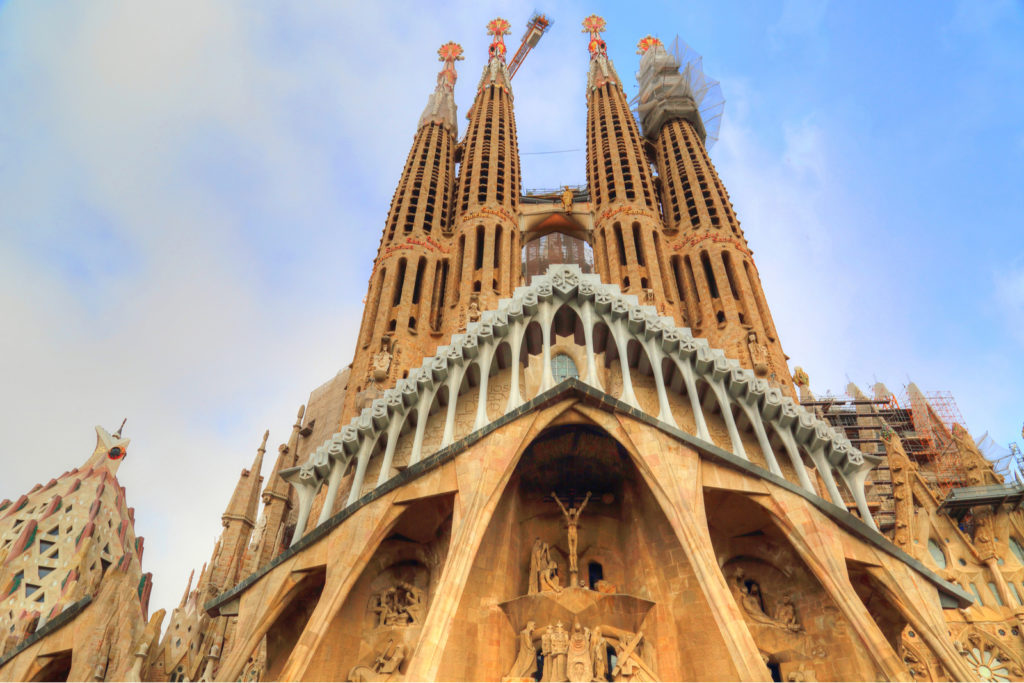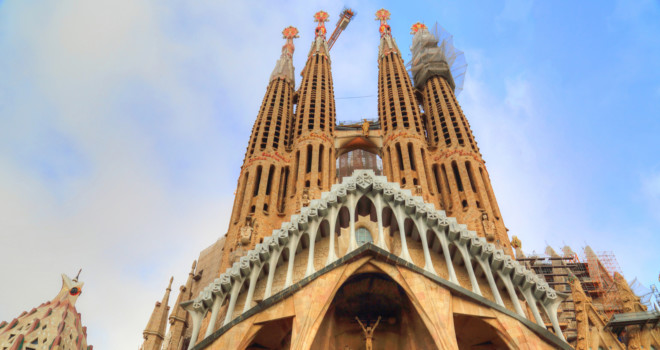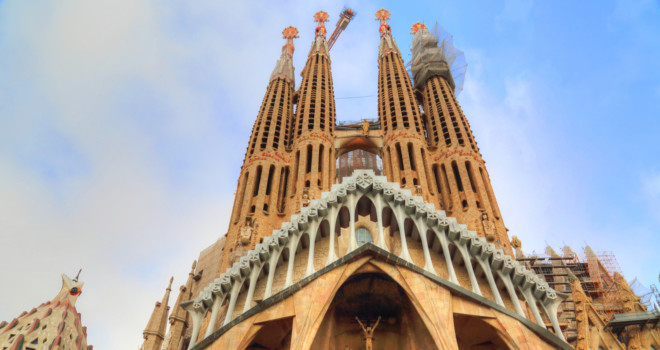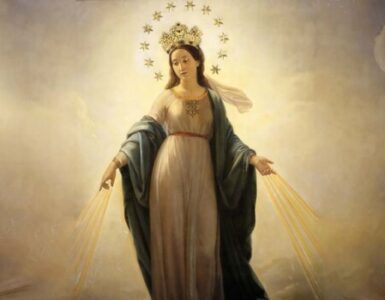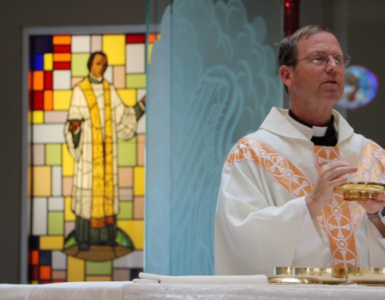Among the precious treasures of the Church that bring about the salvation of souls, which we must recover in order to save our families and rebuild a Christian society, is the Sacrament of Matrimony. Is it not darkened today above all because we rarely proclaim this forgotten gem among the seven sacraments, no longer let it to shine in our lives? We’re given new hope by what is probably the most improbable phenomenon of our time, the construction of the Sagrada Família, the Expiatory Church of the Holy Family, right in the middle of the modern metropolis of Barcelona.
A Rather Reluctant Approach
Some tourists may see the Sagrada Família with its Catalan Modernisme, a rather peculiar type of Art Nouveau, out of the corner of their eye, but may not take it seriously. “Let’s stick to the historical sites,” thought two visitors to Barcelona, the authors of this article, such as the rich architectural fabric in the Barri Gòtic, the largest, still completely preserved Gothic quarter in Europe. One of the most beautiful examples of the Catalan Gothic style in it is the parish church of Santa María del Mar. The apostle James preached long ago in this very place. The purity of its style impressed Gaudí’s youthful spirit, the couple read in their guidebook, as did its building philosophy of a communal effort of Christian spirit that would reverberate in his Sagrada Família.
Our visitors encounter Antoni Gaudí here again: a name they had already noticed on Montserrat, the holy mountain of Catalonia. As a pupil of the architect Francisco del Villar (1828-1901), Gaudí played a major role in designing the apse chapel of the monastery basilica there and created the impressive group of figures of the First Glorious Mystery of the Rosary on the way to the Santa Cova. There the image of grace of Montserrat, his mysterious black Madonna, was found in 880. The spirit in Barri Gòtic was absorbed by Gaudí as a young student of architecture, it is said. Among his teachers was Joan Martorell i Montells (1833-1906), the godfather of the “Gothic rebirth of Catalonia”, who created, among many sacred buildings, the Fourth Joyful, the Fifth Sorrowful and the Third Glorious Mystery of the Rosari Monumental de Montserrat.
Martorell opens up the thinking of the French architect Eugène Viollet-le-Duc (1814-1879) to the young Gaudí at the Escola Técnica Superior d’ Arquitectura: “We must find our creativity through a precise knowledge of the works of our ancestors,” our couple read from their smartphone, increasingly interested in the influences that have formed the mind and creativity of this man Gaudí.
“Not that such knowledge must lead us to slavishly imitate them, but rather it will reveal and make available all the secret abilities of our ancestors,” writes Viollet-le-Duc. “Undoubtedly, the very multiplicity of these skills makes their application difficult today. But when one discovers the secrets that lie behind the finest works in the bosom of the highest and most beautiful civilizations, one quickly realizes that all these secrets can be reduced to a few principles, and that through the kind of fermentation triggered by their combination, new things can and must be created unceasingly.” Gaudí’s interests were wide-ranging, our visitors also learn. At university, he attended lectures on philosophy, aesthetics and history, went to concerts and the theater, read the works of great poetry, toured cultural monuments and nature.
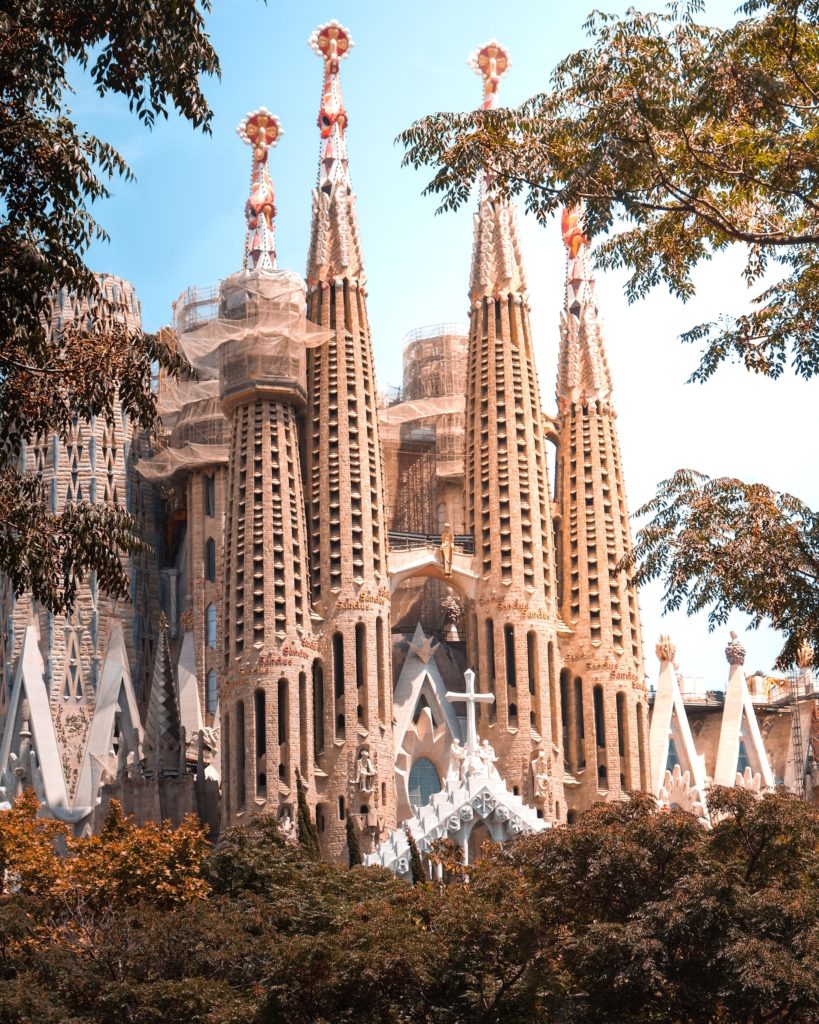
How to Deal with a Cathedral?
Those who, like our couple, carry España en el corazón, Spain in their hearts, no longer try to avoid the Sagrada Família, whose crypt was begun by this same del Villar. It was Martorell who, in 1883, recommended to the young Gaudí, not yet 30 years old, that he continue the construction after del Villar got into a dispute with his clients and resigned. From that year until his death in 1926, Gaudí devoted most of his time and effort to the Sagrada Família. During the last decade of his life, it was his exclusive focus—nothing else mattered to him.
Approaching the Sagrada Família on a late summer afternoon, reddish-gold light reveals something of Gaudi’s building idea from afar. Obviously, it is the strange rock formations of Montserrat, that holy mountain and its motherly mistress Mary, that Gaudi’s towers seek to imitate in the modern metropolis. At their top something shimmers reddish-white, also colorful. In this desert of ugly modern houses in the suburb of Eixample, this strange Gothic appears as other-worldly as the Montserrat, which also seems not to be of this world and appears naturally Gothic, as Gothic as Spanish art, even where it takes up Renaissance or Baroque forms, as in the Churriguera style in Salamanca or in El Greco’s paintings.
“And visitors, how should they deal with a cathedral?” wonders the Polish poet Adam Zagajewski (b.1945). As he recommends for Chartres Cathedral, so our visitors wanted to do with the Sagrada Família. “One should stay longer, one should not be in a hurry like some tourist groups; one should sit down, contemplate, then get up and walk around for a long time.” Will our visitors be like Zagajewski in Chartres, who felt “what is not in the guidebooks, a kind of strong desire, a desire that is neither in the walls nor in the stained glass windows, but in the air of the cathedral, in its lungs”? After some time, after going around the building several times and passing through zones of brightness and shadow, the visual impressions would fade into the background and “into the foreground an ever stronger desire would push itself. We do not know why the cathedral arouses a great desire in us. Why from its dark interior a desire is born…”
Coming closer and closer, our visitors recognized spires with colorful mosaics in plant-like forms. Surprised at first, this thought of Gaudí also made sense to them: Why shouldn’t crucifers bloom and bear fruit on towers that are perceived as Gothic? From ears of wheat and blossoming poppies, the Holy Host rises in radiant white into the blue sky of Catalonia, and from blue grapes a chalice with the Precious Blood. This idea would be compatible with Cistercian architectural ideas, our couple thought. This Catalan modernisme is obviously not Bauhaus modernism, as in the case of post-conciliar churches, or an open breach of tradition. Finally, the path makes a turn through the small park in front of the Sagrada Família, and the Passion facade rises unmediated in the evening light, towered over by four of the blooming Gaudí-Monserrat tower-firs.
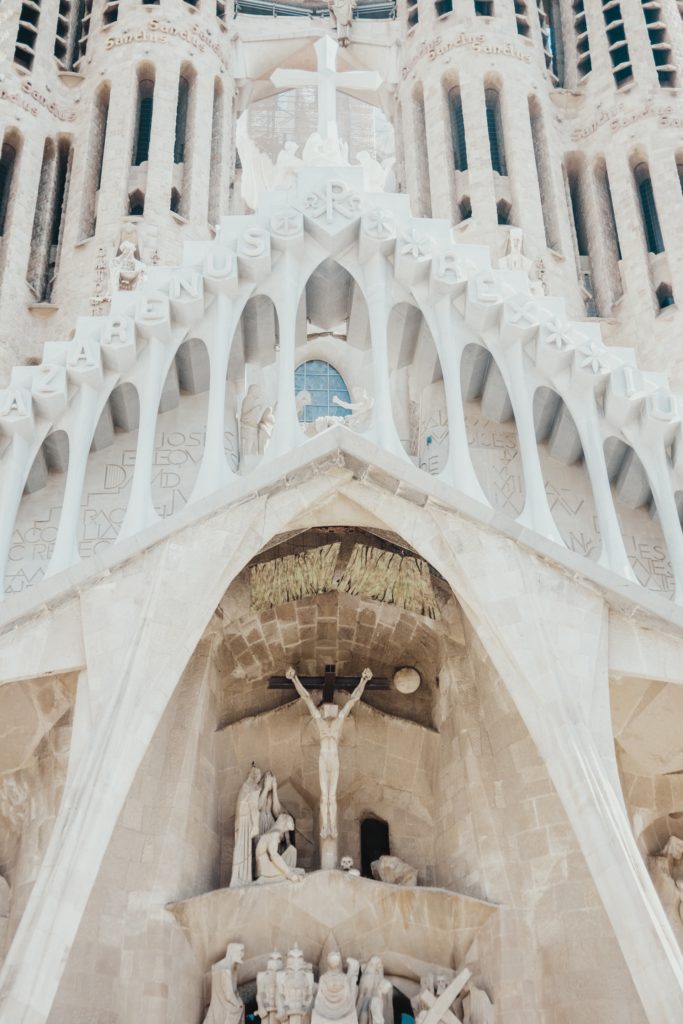
Passion of Christ at the Sagrada Família
“The Passion facade, begun in the late 1980s and not yet completed, attempts to interpret the Passion event in a novel way in crystalline, metallic, sharply cut modernist forms,” our couple read in their guidebook. But what meets their readiness to reject is a surprise: it is indeed the Passion that is unfolding there architecturally and figuratively; it is their suffering Christ on the cross, the Christ of the Gothic plague crosses, it is the assistant figures of the carved Gothic altars—they are there in spirit. They saw their Veronica offering the face of their suffering Lord to the world in the shroud; they saw their scenes on the Mount of Olives, the sleeping disciples, the betrayal, everything that the great masters of Gothic art, the Grünewalds, the Riemenschneiders, all the other precious artists, had brought to them.
From the Last Supper, a winding path leads through the Kiss of Judas, Ecce Homo, the Roman Longinus on horseback, and the nailing to the cross, all the way up to Golgotha. At ground level, wrapped around the central column, is a larger-than-life depiction of a tortured, humiliated Christ, scourged halfway up by Roman soldiers. One of the countless details that captivated the visitors is a “magic square” to the left of the Judas Kiss, in which all the rows and columns of numbers add up to thirty-three – the age of Christ at his sacrificial death. Our couple associate the magic square with Albrecht Dürer’s (1471-1528) master engraving Melencolia I, in which the number adds up to thirty-four.
“With this character Dürer conceived a being endowed with the intellectual power and technical knowledge of an ‘art’, but at the mercy of despair under the cloud of a ‘black humor’,” the German-American art historian Erwin Panofsky (1892-1968) interprets this motif. “He represented a branch of science, geometry, that has become melancholic. […] So Dürer’s Melencolia indeed belongs to those who cannot take their thinking beyond the limits of space. Her persistence in inaction is the behavior of a being that renounces what it could achieve because it cannot achieve what it asks for.” Does this detail symbolize the redemption of the modern spirit from a captivity that ties it purely to the earthly?
The novelty of this depiction of the Passion in the suburbs of a modern metropolis is its timelessness in sober objectivity, connected to tradition without being “conservative”. This moving passion is the revolutionary overcoming of modern “enlightenment,” a pointing out beyond it with the creative means of modernity, a victory over the all-relativizing, all-psychologizing “modernism”. This artistic triumph from the sober objectivity of the form and the rigor corresponding to the event draws its strength from what is always true—and yet it brings forth new figures, which make the strings of the soul vibrate in our visitors and touch their hearts. Peculiar to this façade, but also to the fir-like Montserrat towers, is the element of scripture as a component that joins the figurative: short quotations from the sacred writings and the liturgy that interpret the events. Here, a Moorish-inspired line of tradition in Catalan art may be hinted at.
✠
Editor’s note: This article is the second part in our special series, A Symbol of Rediscovered Faith: The Expiatory Church of the Holy Family in Barcelona. You can click here to see the full series or begin here at part one.
